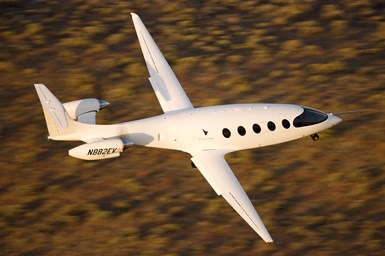GKN Aerospace, Materialise Partnering to Propel Additive Manufacturing in Aviation
Materialise supported the delivery of the additively manufactured wing tip for Eviation’s Alice, the world's largest all-electric aircraft, which made its maiden flight in 2022.
Materialise supported the delivery of the additively manufactured wing tip for Eviation’s Alice, the world's largest all-electric aircraft, which made its maiden flight in 2022. Photo Credit: Materialise
GKN Aerospace, a aerospace technology provider, and Materialise, a provider of 3D printing solutions and services, have signed a Letter of Intent (LOI) aimed at advancing the research, design and production of polymer additively manufactured (AM) parts for the aviation industry. The LOI was signed at the Paris Air Show and represents an extension of their successful collaboration.
Materialise has been a supplier of polymer AM to GKN Aerospace since 2015, and supported the delivery of the additively manufactured wing tip for Eviation’s Alice, the world's largest all-electric aircraft, which made its maiden flight in 2022.
Together, GKN Aerospace and Materialise aim to accelerate the certification of the AM process and push the boundaries of additive production of functional and flight-critical aerostructures, leveraging its manufacturing benefits.
The collaboration ranges from prototyping to the production of functional and flight-critical parts, aligning with the industry’s emerging sustainability trends and opportunities. In particular, the partnership will focus on electric vertical takeoff and landing (eVTOL) aircraft.
GKN Aerospace and Materialise’s collaboration has already enabled significant AM milestones, including the successful delivery and certification of multiple AM parts that are flying today. “This powerful alliance aims to leverage our combined expertise and the exceptional benefits of 3D printing to push the boundaries of innovation in the aeronautics industry,” says Jurgen Laudus, Vice President of Materialise Manufacturing. Together, the partners say they are are working to drive technological advancements, respond more effectively to customer requirements and shape the future of aerospace manufacturing.
“Materialise is a valued AM supplier for GKN Aerospace and partnering with them on this groundbreaking technology has been a success for both companies,” says Russ Brigham, GKN Aerospace program director. “AM is out there and flying on aircraft around the world today, and will be critical to achieve a more sustainable future of flight ahead.”
The potential for AM to revolutionize the aviation industry is significant, with the creation of lighter and stronger parts that were previously unachievable with conventional manufacturing technologies, while also offering time and cost reductions during the manufacturing process.
GKN Aerospace and Materialise bring complementary manufacturing experience across multiple AM printing technologies. Materialise has more than three decades of experience. It has helped pioneer the production of certified parts for various industries and provides EASA 21.G-certified flying parts, software solution and consultancy services for the aerospace industry. GKN Aerospace, a global technology provider in AM, has load-bearing AM structures certified and in serial production, as well as numerous other AM parts flying today for commercial, military, rotorcraft and space applications.
- Read this article about GKN Aerospace’s successful tests lightweight turbine rear structure. The company says an innovative design and manufacturing of shorter, lighter turbine rear structure can contribute to lower carbon emissions.
- Here’s information on how Materialise’s enhanced Magics Software enables traceability, connectivity and automation. The updated Magics workflow automation software helps improve product quality by creating an advanced digital thread connecting the entire manufacturing process.
Related Content
How Large-Format 3D Printing Supports Micro-Scale Hydropower
There is potential hydroelectric power that has never been unlocked because of the difficulty in capturing it. At Cadens, additive manufacturing is the key to customizing micro-scale water turbine systems to generate electricity from smaller dams and waterways.
Read MoreConcept Sneaker Boasts One-Piece 3D Printed TPU Construction
The Reebok x Botter Concept Sneaker Engineered by HP premiered at Paris Fashion Week, hinting at manufacturing possibilities for the future of footwear.
Read MoreEvaluating the Printability and Mechanical Properties of LFAM Regrind
A study conducted by SABIC and Local Motors identified potential for the reuse of scrap reinforced polymer from large-format additive manufacturing. As this method increases in popularity, sustainable practices for recycling excess materials is a burgeoning concern.
Read MoreCan the U.S. Become Self-Sufficient in Aerospace Alloy Metal Powders?
6K’s technology can upcycle titanium and nickel-alloy parts into additive manufacturing powder. Here is how the circular economy helps national security.
Read MoreRead Next
3D Printing Brings Sustainability, Accessibility to Glass Manufacturing
Australian startup Maple Glass Printing has developed a process for extruding glass into artwork, lab implements and architectural elements. Along the way, the company has also found more efficient ways of recycling this material.
Read More4 Ways the Education and Training Challenge Is Different for Additive Manufacturing
The advance of additive manufacturing means we need more professionals educated in AM technology.
Read MoreAt General Atomics, Do Unmanned Aerial Systems Reveal the Future of Aircraft Manufacturing?
The maker of the Predator and SkyGuardian remote aircraft can implement additive manufacturing more rapidly and widely than the makers of other types of planes. The role of 3D printing in current and future UAS components hints at how far AM can go to save cost and time in aircraft production and design.
Read More






















